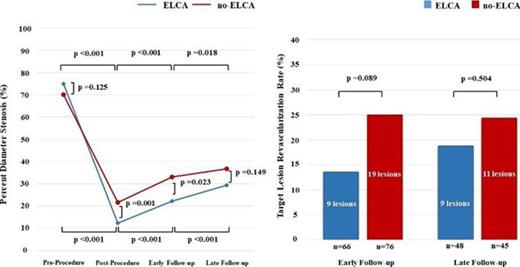-
Views
-
Cite
Cite
T Higaki, K Nishioka, K Suruga, H Takemoto, T Nakano, Y Hashimoto, S Tomomori, K Oi, K Dai, T Kawase, Y Nakama, K Suenari, M Otsuka, Y Masaoka, N Shiode, P2694
Early and late restenosis after excimer laser coronary angioplasty and paclitaxel-coated balloon combination therapy for drug-eluting stent restenosis, European Heart Journal, Volume 40, Issue Supplement_1, October 2019, ehz748.1011, https://doi.org/10.1093/eurheartj/ehz748.1011Close - Share Icon Share
Abstract
Drug-eluting stent restenosis (DES-ISR) is associated with poorer outcomes than those of bare-metal stent restenosis after treatment with paclitaxel-coated balloon (PCB), and late restenosis after PCB angioplasty for DES-ISR is a residual problem. Excimer laser coronary angioplasty (ELCA) is thought to be advantageous for ISR treatment by removing neointima. However, whether the combination of ELCA and PCB angioplasty is more effective than the use of PCB only angioplasty in DES-ISR has not been studied so far.
We evaluated the efficacy of ELCA and PCB combination therapy for DES-ISR at mid-and late-term after revascularization.
From January 2014 to March 2016, 166 DES-ISR lesions were treated with ELCA and no-ELCA prior to PCB. Two serial angiographic follow-ups were planned for the patients (at 6–12 and 18–24 months after procedure). Acute procedural and follow-up angiographic results were assessed by quantitative coronary angiography. ELCA and no-ELCA group included 74 lesions and 92 lesions, respectively.
There was no significant difference between the two groups in the clinical characteristics except the prevalence of hemodialysis, the rate of first-generation DES (37.9% vs 36.8%, p=0.897), previous stent size (2.90±0.39 mm vs 2.77±0.39 mm, p=0.063), and reference vessel diameter (2.65±0.46 mm vs 2.60±0.65 mm, p=0.593). Early follow-up angiography was performed in 66 lesions (89.1%) of ELCA group, and was done in 76 lesions (82.6%) of no-ELCA group. In the ELCA group, percentage diameter stenosis (%DS) just after procedure and at 6–12 months later were significantly smaller than those of no-ELCA group. Besides, target lesion revascularization (TLR) rate at 6–12 months after procedure was tended to be lower in the ELCA group. Late follow-up angiography was performed for 93 lesions (81.6%) of the remaining 114 lesions (excluding TLR lesion), late restenosis was found 9 lesions (18.6%) in the ELCA group and 11 lesions (24.4%) in the no-ELCA group (p=0.504). Late luminal loss was similar in both groups (0.37±0.71 mm vs 0.24±0.82 mm, p=0.438), and %DS at 12–18 months after revascularization was not different between the two groups.

Changes of %DS and TLR rate
%DS in the ELCA group was smaller at just after procedure and the advantage was kept even after 1-year. However, late restenosis and TLR at 2-year after revascularization for DES-ISR could not be reduced by ELCA and PCB combination therapy.
- angiogram
- paclitaxel
- stents
- coronary angiography
- hemodialysis
- coronary arteriosclerosis
- restenosis
- balloon dilatation
- excimer laser angioplasty
- angioplasty
- combined modality therapy
- constriction, pathologic
- follow-up
- phenobarbital
- metallic stents
- drug-eluting stents
- revascularization
- diameter
- neointima





